NURS FPX 6610 Case Presentation of a Patient Paper Example
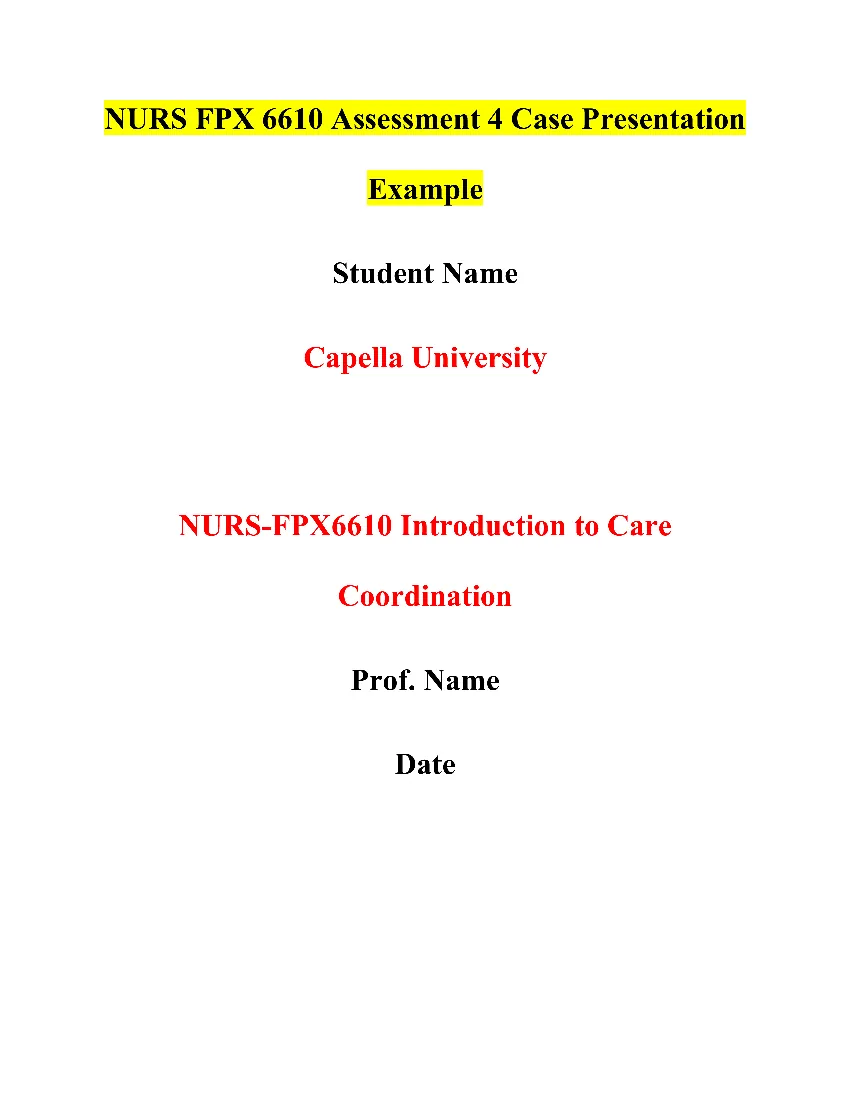 NURS FPX 6610 Assessment 4 Case Presentation
NURS FPX 6610 Assessment 4 Case Presentation
NURS FPX 6610 Case Presentation of a Patient Paper Assignment Brief
Course: NURS-FPX6610 Introduction to Care Coordination
Assignment Title: NURS FPX 6610 Assessment 4 Case Presentation
Assignment Overview
In this assessment, you will develop a presentation of a patient’s case for stakeholders, supplemented by 10–15 slides with notes. The ability to deliver effective presentations is crucial for care coordinators, particularly when addressing diverse groups of stakeholders, including patients, family members, and multiple providers in various settings. This assessment provides an opportunity for you to present a patient’s case to stakeholders, demonstrating your proficiency in key course competencies.
Understanding Assignment Objectives
This assignment aims to evaluate your ability to:
- Explain the effect of societal, economic, and interprofessional factors on patient outcomes and the care coordinator’s role.
- Evaluate care coordination plans and outcomes according to performance measures and professional standards.
- Develop collaborative interventions that address the needs of diverse populations and varied settings.
- Communicate effectively with diverse audiences, presenting patient case information to stakeholders clearly and accurately, and supporting main points with relevant evidence.
The Student’s Role
As a student in this assignment, your role is to prepare and deliver a comprehensive presentation of a patient’s case to stakeholders. You will analyze the patient’s background, care plan, and transitional care plan, identifying key goals, elements, and factors influencing outcomes. Additionally, you will explain how an interprofessional care team contributes to high-quality patient outcomes and determine the resources needed for continuing care.
You Can Also Check Other Related Assessments for the NURS-FPX6610 Introduction to Care Coordination Course:
NURS FPX 6610 Assessment 1 Comprehensive Needs Assessment Example
NURS FPX 6610 Case Presentation of a Patient Paper Example
Slide 1: Title Slide
Title: Comprehensive Case Presentation for Mrs. Snyder’s Continuing Care
Course Code: NURS FPX 6610
Presenter’s Name: [Student’s Name]
Date: [Date of Presentation]
Speaker Notes:
- Good morning/afternoon, everyone. Today, I’m excited to present a comprehensive case study focusing on Mrs. Snyder’s continuing care.
- We’ll look at the details of transitional care, stakeholder engagement, and the multidisciplinary approach to ensure optimal patient outcomes for Mrs. Snyder.
- Let’s dive into the details of Mrs. Snyder’s case and explore the collaborative efforts of healthcare professionals in providing patient-centered care.
Slide 2: Introduction
Importance of Case Studies in Healthcare
- Case studies play a crucial role in providing insights into patient care (Hinchliffe et al., 2020).
- They offer comprehensive patient information, aiding healthcare providers in understanding diagnoses, treatment options, and potential health issues.
Speaker Notes:
- Case studies serve as invaluable tools for healthcare professionals, offering a detailed overview of patient cases.
- In today’s presentation, we’ll explore how case studies, particularly Mrs. Snyder’s, contribute to our understanding of transitional care and collaborative patient management.
Slide 3: Transitional Care Plan and Goals
Definition of Transitional Care
- Transitional care focuses on ensuring the smooth transition of patients between healthcare settings (Daliri et al., 2019).
- Its primary goal is to uphold the quality of care while respecting patients’ preferences and needs during transitions.
Goals of Continuing Care for Mrs. Snyder
- Ensure seamless transfer between healthcare settings.
- Uphold the quality of care and treatment.
- Respect religious and cultural beliefs, particularly in Mrs. Snyder’s case (Lianov et al., 2020).
Speaker Notes:
- Transitional care is essential for patients like Mrs. Snyder who require transfer between medical centers.
- The goal is to facilitate a stress-free transition for Mrs. Snyder while maintaining the quality of care and respecting her religious and cultural preferences.
Slide 4: Stakeholder Engagement
Role of Stakeholders in Patient Health and Safety
- Stakeholders play a crucial role in shaping patient care and well-being (Lianov et al., 2020).
- Their involvement ensures that patients receive optimal care and support throughout their healthcare journey.
Importance of Stakeholder Collaboration in Mrs. Snyder’s Case
- Collaborative efforts are essential in ensuring a smooth transfer process for Mrs. Snyder.
- Healthcare professionals must prioritize her needs and preferences, including cultural considerations like providing kosher food (Lianov et al., 2020).
Speaker Notes:
- Stakeholders, including healthcare professionals and family members, play a pivotal role in Mrs. Snyder’s care.
- Collaboration ensures that Mrs. Snyder’s transfer is seamless and that her cultural and religious beliefs are respected throughout the process.
Slide 5: Elements of Continuous Care
Components of Continuous Care
- Medical record analysis: Understanding Mrs. Snyder’s medical history and current health status (Asmirajanti et al., 2019).
- Patient evaluation: Assessing Mrs. Snyder’s physical, emotional, and cultural needs.
- Emotional support: Providing Mrs. Snyder with the necessary support to navigate her healthcare journey effectively.
Importance of Understanding Mrs. Snyder’s Medical History
- Mrs. Snyder’s medical history, including her battle with ovarian cancer and diabetes, informs her ongoing treatment and care plan (Khanlarkhani et al., 2021).
Speaker Notes:
- Continuous care involves a comprehensive approach to Mrs. Snyder’s health and well-being.
- Understanding her medical history and current health status is crucial for tailoring effective treatment plans and ensuring optimal outcomes.
Slide 6: Mrs. Snyder’s Health Assessment
Overview of Mrs. Snyder’s Health Issues
- Mrs. Snyder faces multiple health challenges, including ovarian cancer, diabetes, and stress-related issues (Khanlarkhani et al., 2021; Demir et al., 2021).
- These conditions significantly impact her overall well-being and require specialized care and attention.
Impact on Mrs. Snyder’s Well-being
- Mrs. Snyder’s health issues pose significant challenges, affecting her physical and emotional health (Khanlarkhani et al., 2021; Demir et al., 2021).
- Understanding the extent of these challenges is essential for developing a comprehensive care plan tailored to her needs.
Speaker Notes:
- Mrs. Snyder’s health assessment reveals the complexity of her medical condition.
- Her health issues, including ovarian cancer and diabetes, require a holistic approach to address both physical and emotional well-being.
Slide 7: Interprofessional Care Team
Composition of Mrs. Snyder’s Care Team
- Mrs. Snyder’s care team comprises various specialists, including oncologists, endocrinologists, and nurses (Ansa et al., 2020).
- Each team member plays a unique role in managing her complex health issues and ensuring coordinated care.
Speaker Notes:
- Mrs. Snyder’s care team consists of a diverse group of healthcare professionals, each bringing their expertise to her treatment.
- Collaboration among team members is essential for ensuring comprehensive care and optimal patient outcomes.
Slide 8: Factors Affecting Patient Outcomes
Determinants of Patient Outcomes
- Patient outcomes can be influenced by various factors, including economic status, lifestyle choices, and social support systems (Chung et al., 2020).
- Understanding these determinants is crucial for developing a tailored care plan that addresses Mrs. Snyder’s unique circumstances.
Speaker Notes:
- Several factors, including economic status and social support, can impact patient outcomes.
- Recognizing these determinants allows us to develop a care plan that addresses Mrs. Snyder’s individual needs and challenges.
Slide 9: Assumptions and Areas of Uncertainty
Acknowledging Assumptions in Mrs. Snyder’s Case
- Cultural and religious considerations: Assumptions about Mrs. Snyder’s dietary preferences and religious beliefs must be taken into account.
- Family dynamics: Understanding Mrs. Snyder’s family situation and support network is essential for providing comprehensive care.
Addressing Areas of Uncertainty
- Uncertainties may arise throughout Mrs. Snyder’s care journey, requiring flexibility and adaptability from healthcare providers.
- Ongoing training and communication among the care team are essential for addressing uncertainties effectively.
Speaker Notes:
- Assumptions about Mrs. Snyder’s cultural and religious preferences guide our approach to her care.
- However, uncertainties may arise, necessitating ongoing communication and flexibility among the care team.
Slide 10: Determination of Required Resources
Essential Resources for Mrs. Snyder’s Care
- Monitoring vital signs: Regular assessment of Mrs. Snyder’s health indicators, including blood pressure and blood sugar levels (Howell et al., 2020).
- Dietary modifications: Providing Mrs. Snyder with appropriate dietary options, including kosher food, to meet her cultural and religious needs (Lianov et al., 2020).
Speaker Notes:
- Adequate resources, including monitoring equipment and dietary options, are essential for Mrs. Snyder’s care.
- Ensuring access to these resources is crucial for maintaining her health and well-being throughout her healthcare journey.
Slide 11: Conclusion
Key Takeaways
- Comprehensive transitional care is essential for patients like Mrs. Snyder, who require transfer between healthcare settings.
- Interprofessional collaboration and patient-centered care are vital for ensuring optimal outcomes and addressing patients’ individual needs.
Speaker Notes:
- Mrs. Snyder’s case highlights the importance of collaborative, patient-centered care in achieving optimal outcomes.
- By prioritizing her needs and preferences, we can ensure that Mrs. Snyder receives the support and resources necessary for a smooth transition and recovery journey.
Slide 12: References
Ansa, B. E., Zechariah, S., Gates, A. M., Johnson, S. W., Heboyan, V., & De Leo, G. (2020). Attitudes and behavior towards interprofessional collaboration among healthcare professionals in a large academic medical center. Healthcare, 8(3), 323. https://doi.org/10.3390/healthcare8030323
Asmirajanti, M., Hamid, A. Y. S., & Hariyati, Rr. T. S. (2019). Nursing Care Activities Based on Documentation. BMC Nursing, 18(1). https://doi.org/10.1186/s12912-019-0352-0
Chung, G. K.-K., Dong, D., Wong, S. Y.-S., Wong, H., & Chung, R. Y.-N. (2020). Perceived poverty and health, and their roles in the poverty-health vicious cycle: A qualitative study of major stakeholders in the healthcare setting in Hong Kong. International Journal for Equity in Health, 19(1). https://doi.org/10.1186/s12939-020-1127-7
Daliri, S., Hugtenburg, J. G., ter Riet, G., van den Bemt, B. J. F., Buurman, B. M., Scholte op Reimer, W. J. M., van Buul-Gast, M.-C., & Karapinar-Çarkit, F. (2019). The effect of a pharmacy-led transitional care program on medication-related problems post-discharge A before—After prospective study. Plos One, 14(3), 0213593. https://doi.org/10.1371/journal.pone.0213593
Demir, S., Nawroth, P. P., Herzig, S., & Ekim Üstünel, B. (2021). Emerging targets in type 2 diabetes and diabetic complications. Advanced Science, 8(18), 2100275. https://doi.org/10.1002/advs.202100275
Hinchliffe, R. J., Forsythe, R. O., Apelqvist, J., Boyko, E. J., Fitridge, R., Hong, J. P., Katsanos, K., Mills, J. L., Nikol, S., Reekers, J., Venermo, M., Zierler, R. E., & Schaper, N. C. (2020). Guidelines on diagnosis, prognosis, and management of peripheral artery disease in patients with foot ulcers and diabetes (IWGDF 2019 update). Diabetes/Metabolism Research and Reviews, 36(1). https://doi.org/10.1002/dmrr.3276
Slide 13: Q&A
- Inviting Questions from Stakeholders
Speaker Notes:
- Thank you for your attention. I’m happy to address any questions or concerns you may have about Mrs. Snyder’s case or our approach to her care.
- Please feel free to ask any questions, and I’ll do my best to provide comprehensive answers based on the information presented today.
Detailed Assessment Instructions for the NURS FPX 6610 Case Presentation of a Patient Paper Assignment
Description
Assessment 3 Instructions: Case Presentation of a Patient Paper
- Develop a presentation of the patient’s case for stakeholders, supplemented by 10–15 slides with notes.
Note: Each assessment in this course builds on your work from the preceding assessment; therefore, complete the assessments in the order in which they are presented. - The ability of care coordinators to deliver effective presentations can have a significant impact on the quality of patient care, particularly when addressing a diverse group of stakeholders, including the patient, family members, and multiple providers in a range of different settings. This assessment provides an opportunity for you to present Mrs. Snyder’s case to stakeholders.
Communication and interdisciplinary collaboration include the patients and their families or significant others. Care coordinators understand that patients may need help navigating the complex health care system and that partnering with patients and their families improves education, safety, and patient outcomes.
By successfully completing this assessment, you will demonstrate your proficiency in the following course competencies and assessment criteria:- Competency 2: Explain the effect of societal, economic, and interprofessional factors on patient outcomes and the care coordinator’s role.
- Identify the factors that could affect outcomes for a patient.
- Competency 3: Evaluate care coordination plans and outcomes according to performance measures and professional standards.
- Determine the resources needed to implement continuing care.
- Competency 4: Develop collaborative interventions that address the needs of diverse populations and varied settings.
- Identify the goals, elements, and overall scope of a plan for continuing care.
- Explain how an interprofessional care team delivers high-quality patient outcomes.
- Competency 5: Communicate effectively with diverse audiences, in an appropriate form and style, consistent with applicable organizational, professional, and scholarly standards.
- Present patient case information to stakeholders clearly and accurately.
- Support main points, arguments, and conclusions with relevant and credible evidence, correctly formatting citations and references using APA style.
- Competency Map
CHECK YOUR PROGRESSUse this online tool to track your performance and progress through your course.
- Competency 2: Explain the effect of societal, economic, and interprofessional factors on patient outcomes and the care coordinator’s role.
- Toggle DrawerResources
- Asssessment InstructionsNote: Complete the assessments in this course in the order in which they are presented.
Preparation
For your final assessment, you will present Mrs. Snyder’s case to the health care team, including all internal and external stakeholders and key family members. The purpose of the presentation is to ensure that everyone connected with Mrs. Snyder’s case is well informed and that they have a common understanding of her care to date and of plans for providing the best possible patient-centered care.
To prepare for the presentation, you are encouraged to review the care plan and the transitional care plan that you developed for Mrs. Snyder in Assessments 2 and 3.
Note: Remember that you can submit all or a portion of your presentation draft to Smarthinking for feedback before you submit the final version for this assessment. If you plan on using this free service, be mindful of the turnaround time of 24–48 hours for receiving feedback.
Presentation Software
You may use Microsoft PowerPoint or any other suitable presentation software to create your slides. Use the speaker’s notes section of each slide to develop your talking points and cite your sources, as appropriate. If you need help designing your presentation, you are encouraged to review the various presentation resources provided.
Inclusion of audio voiceover or video is optional. Required information should be included in the slides and speaker notes.
You may use Kaltura or another technology of your choice to record your presentation. If using Kaltura, refer to the Using Kaltura page for directions on recording and uploading your video in the courseroom.
Example Assessment: You may use the following to give you an idea of what a Proficient or higher rating on the scoring guide would look like:- Assessment 4 Example [PPTX].
- Requirements
Develop a presentation of your patient’s case for stakeholders.
Presentation Format and Length
Your slide deck should consist of 10–15 slides, not including the title slide, objectives slide, and references slide.
Supporting Evidence - Cite 3–5 sources of scholarly or professional evidence to support your presentation.
- List your sources on the references slide at the end of your presentation.
- Developing the Presentation
The requirements outlined below correspond to the grading criteria in the scoring guide. Be sure that your case presentation addresses each point, at a minimum. Read the Case Presentation Scoring Guide to better understand how each criterion will be assessed. - Identify the goals, elements, and overall scope of a plan for continuing care.
- Include a high-level overview of the care plan and the transitional care plan, with relevant background on the patient.
- Explain how an interprofessional care team delivers high-quality patient outcomes.
- Include and address the various roles associated with particular care coordination functions.
- Cite credible evidence to support your conclusions.
- Consider the informational needs of various stakeholders and their familiarity with care coordination.
- Identify the factors that could affect outcomes for a patient.
- Specify the information on which are you basing your conclusions.
- Note any assumptions you are making about the specific patient, her needs, and the nature of ongoing care.
- Determine the resources needed to implement continuing care.
- Identify the factors that influence your determination.
- Justify your assertions, specific to Mrs. Snyder’s case.
- Present patient case information to stakeholders clearly and accurately.
- Express your main points and conclusions coherently.
- Proofread your slides to minimize errors that could distract readers and make it difficult to focus on the substance of your presentation.
- Support main points, arguments, and conclusions with relevant and credible evidence, correctly formatting citations and references using APA style.
- Ensure that the evidence you provide is clear, explicit, and understood by all stakeholders.
- Additional Requirements
Submit your slide deck and, if you included audio voiceover or video, a link to your recording. If you used technology other than PowerPoint or Kaltura to create your slides or recording, make sure to submit any other relevant documentation or links for this assessment.
Portfolio Prompt: You may choose to save your presentation to your ePortfolio.
Boost Your Grades with ReliablePapers.com – Your Expert Nursing Paper Writing Service!
Are you struggling with nursing research papers or assignments? Look no further! At ReliablePapers.com, we’re your trusted nursing writing service, committed to delivering customized and original nursing papers for top-notch grades.
Writing Nursing Assignments Made Easy
Dealing with complex topics, tight deadlines, or specific instructions? Our skilled nursing essay writers are here to help. From crafting custom nursing research papers to assisting with nursing assignments, we ensure top grades for your academic success.
Timely Support for Your Coursework, Top Grade Assured
With years of experience helping nursing students with coursework, we efficiently handle orders even with tight deadlines. Our expert nursing writers create outstanding papers from scratch, addressing any topic, meeting any deadline, and following your specific instructions.
Why Choose Nursing Paper Writing Services at ReliablePapers.com?
- Affordable Prices: Our online nursing papers are priced affordably, ensuring accessibility for all college students.
- Expert Writers: Let our skilled writers make your paper perfect, providing the expertise needed for exceptional results.
- Originality Guaranteed: Say goodbye to plagiarized papers. Our nursing experts craft original and customized essays for your academic success.
- Easy Ordering Process: Ready to place your order? It’s hassle-free! Visit our “Place Order” page, provide paper details, proceed to checkout, and your order will be assigned to a suitable expert.
Why Trust Our Professionals?
Our skilled writers at ReliablePapers.com are updated with the latest nursing trends, ensuring your research paper stands out. Trust us for your academic success – our online nursing essays are unmatched both in quality and affordability.
As a nursing student, balancing assignments and class participation can be overwhelming. Seek help to submit research on time and ensure exceptional performance in your nursing papers. Trust ReliablePapers.com for your academic success! Order your nursing essays today, save time, and secure the grades you deserve.
Don’t wait until the last minute; fill in your requirements, and let our experts deliver your work ASAP. Place Your Order Now.
Hire an Expert Paper Writer on Any Subject, Any Topic, Any Deadline! Submit your paper instructions by placing your order here to get started!


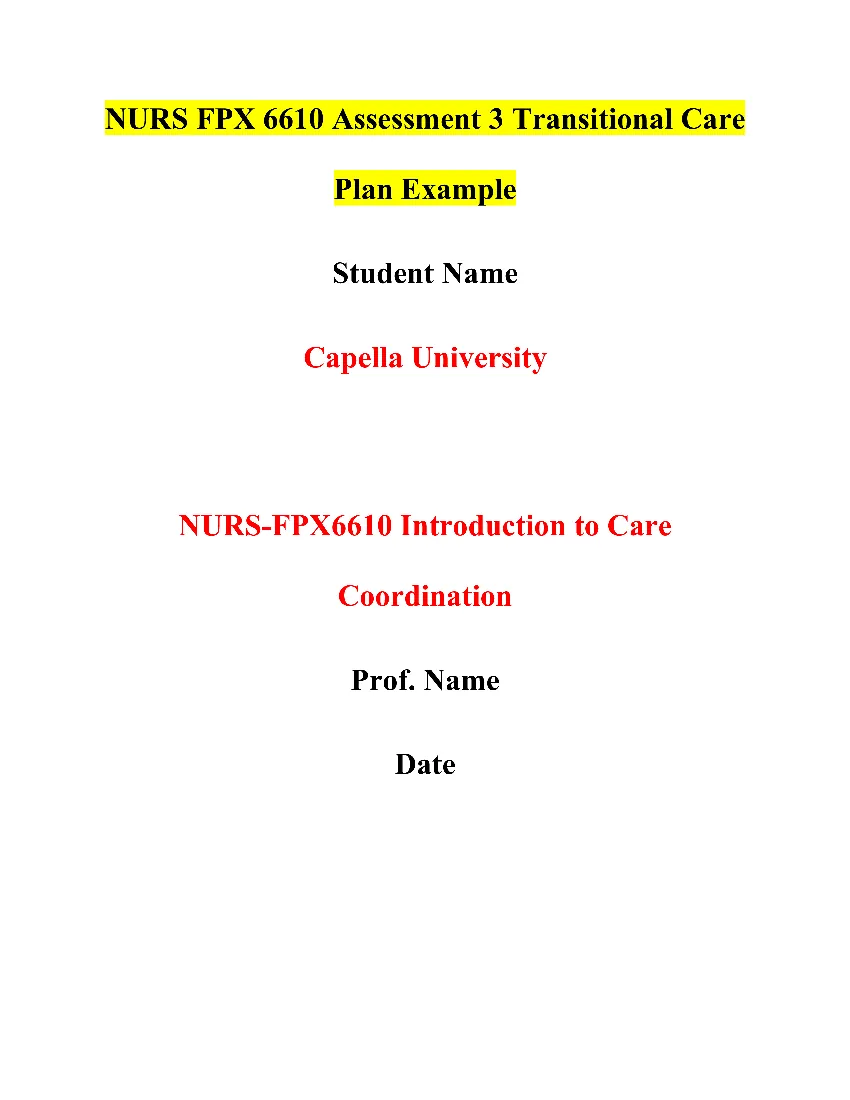 NURS FPX 6610 Assessment 3 Transitional Care Plan
NURS FPX 6610 Assessment 3 Transitional Care Plan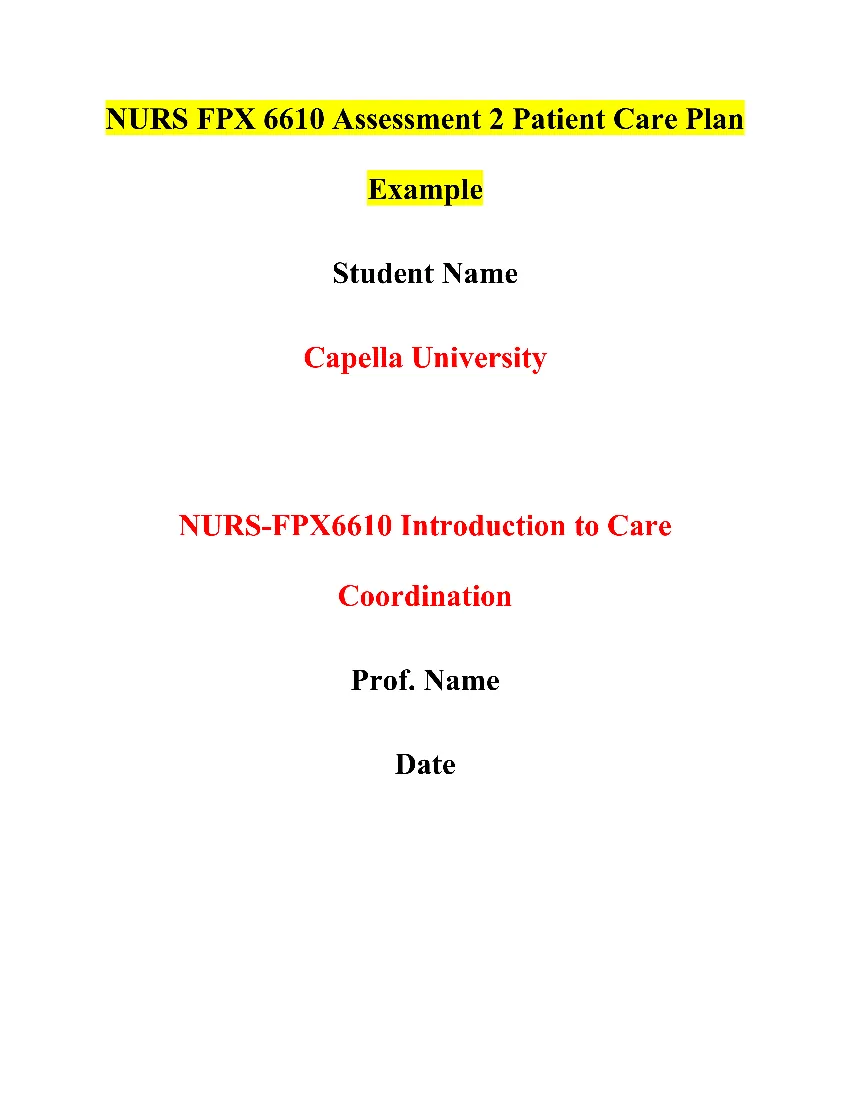 NURS FPX 6610 Assessment 2 Patient Care Plan
NURS FPX 6610 Assessment 2 Patient Care Plan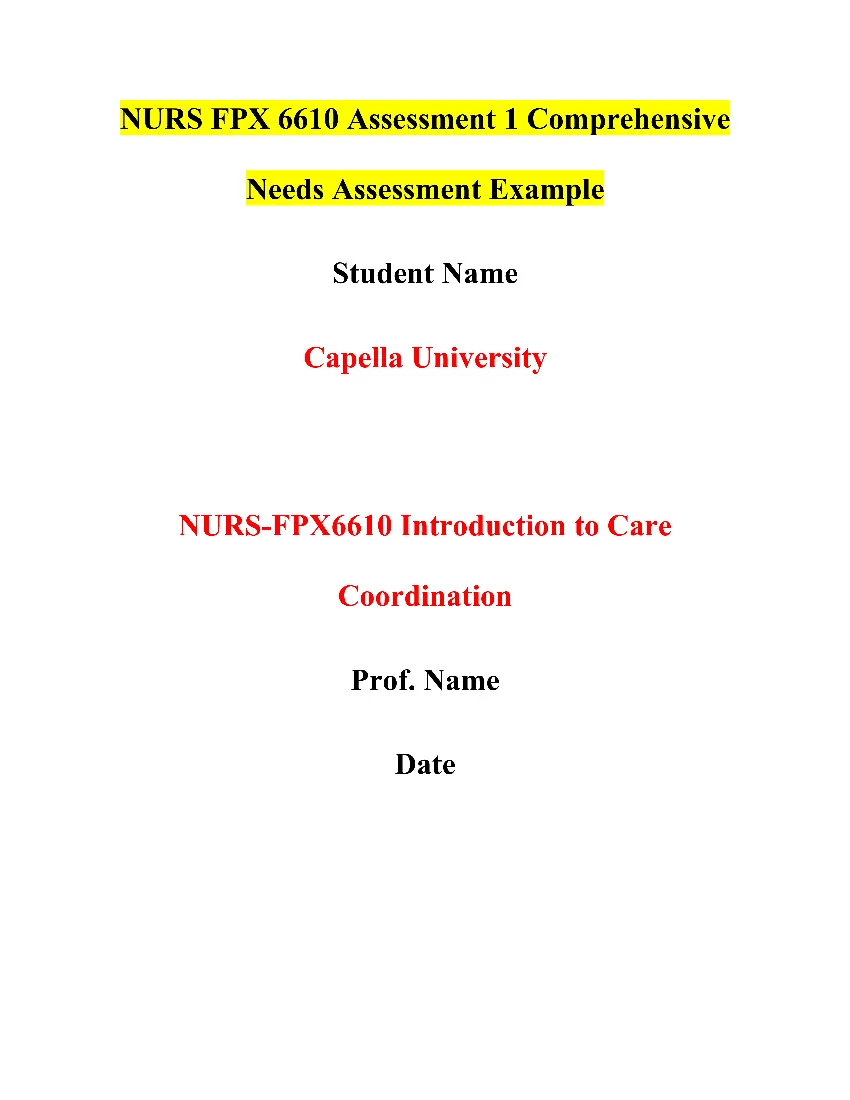 NURS FPX 6610 Assessment 1 Comprehensive Needs Assessment
NURS FPX 6610 Assessment 1 Comprehensive Needs Assessment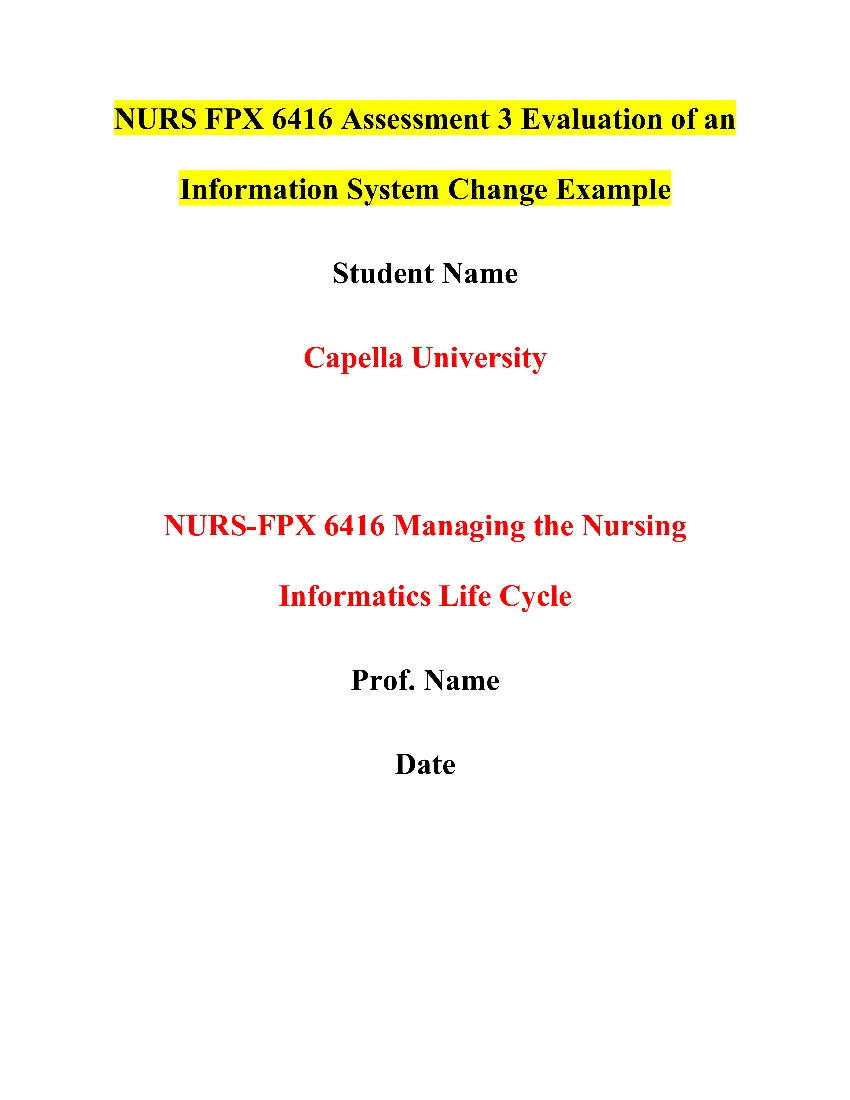 NURS FPX 6416 Assessment 3 Evaluation of an Information System Change
NURS FPX 6416 Assessment 3 Evaluation of an Information System Change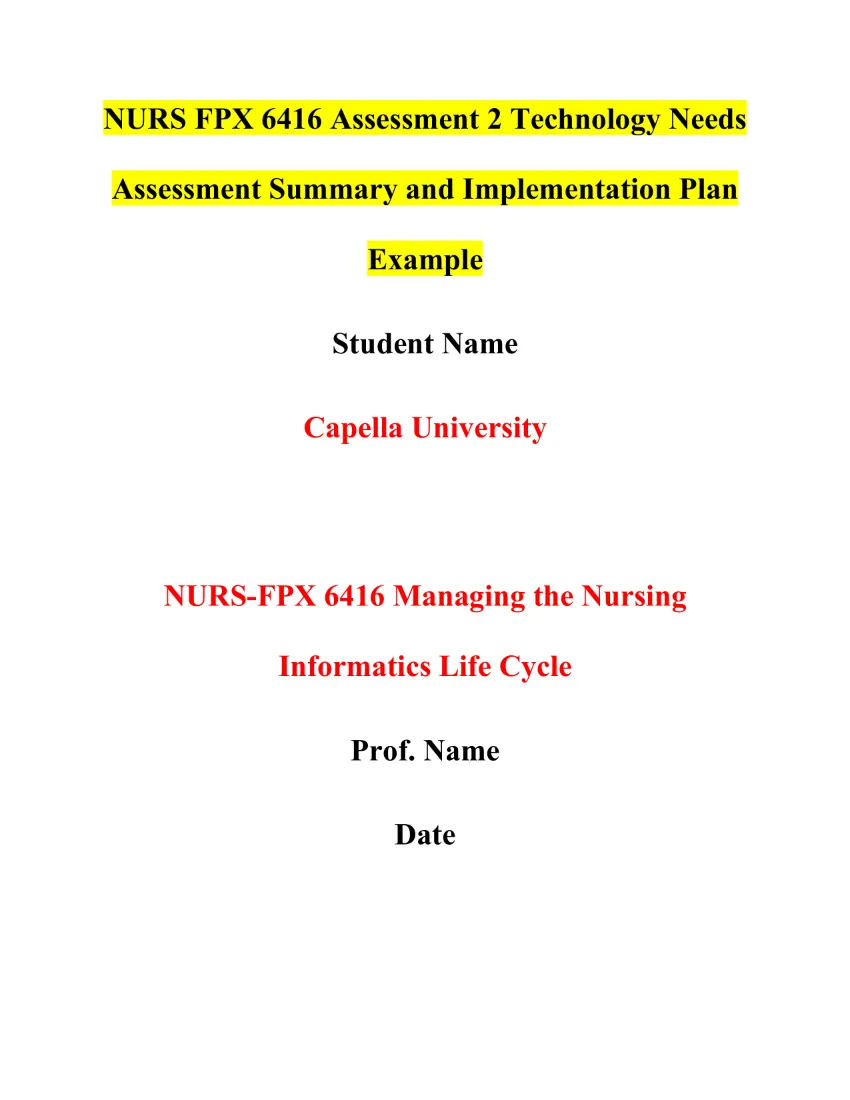 NURS FPX 6416 Assessment 2 Technology Needs Assessment Summary and Implementation Plan
NURS FPX 6416 Assessment 2 Technology Needs Assessment Summary and Implementation Plan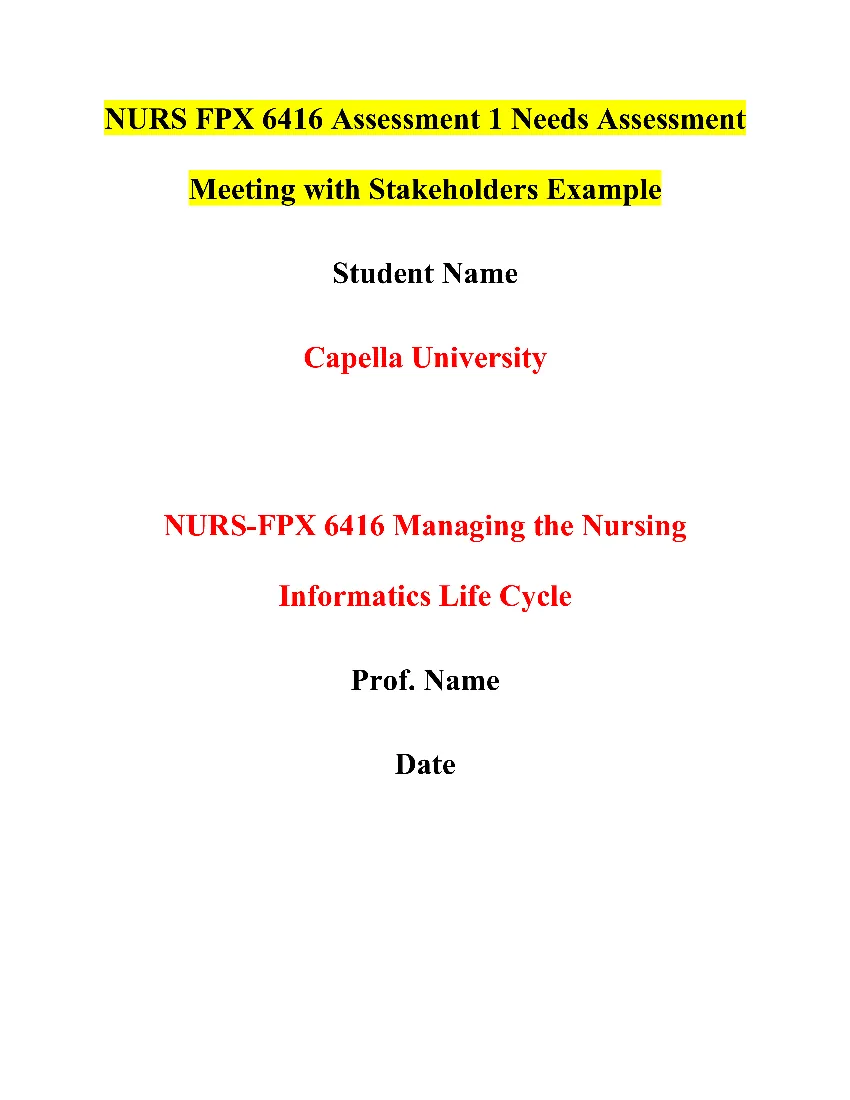 NURS FPX 6416 Assessment 1 Needs Assessment Meeting with Stakeholders
NURS FPX 6416 Assessment 1 Needs Assessment Meeting with Stakeholders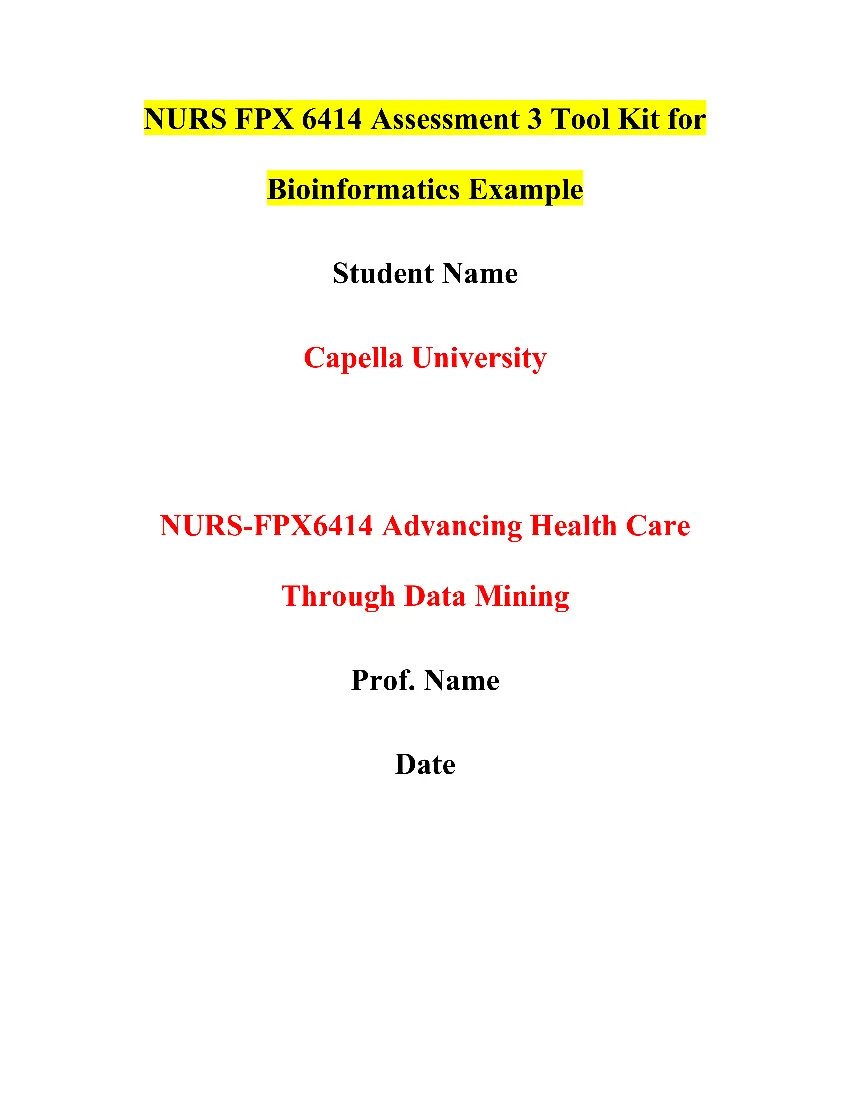 NURS FPX 6414 Assessment 3 Tool Kit for Bioinformatics
NURS FPX 6414 Assessment 3 Tool Kit for Bioinformatics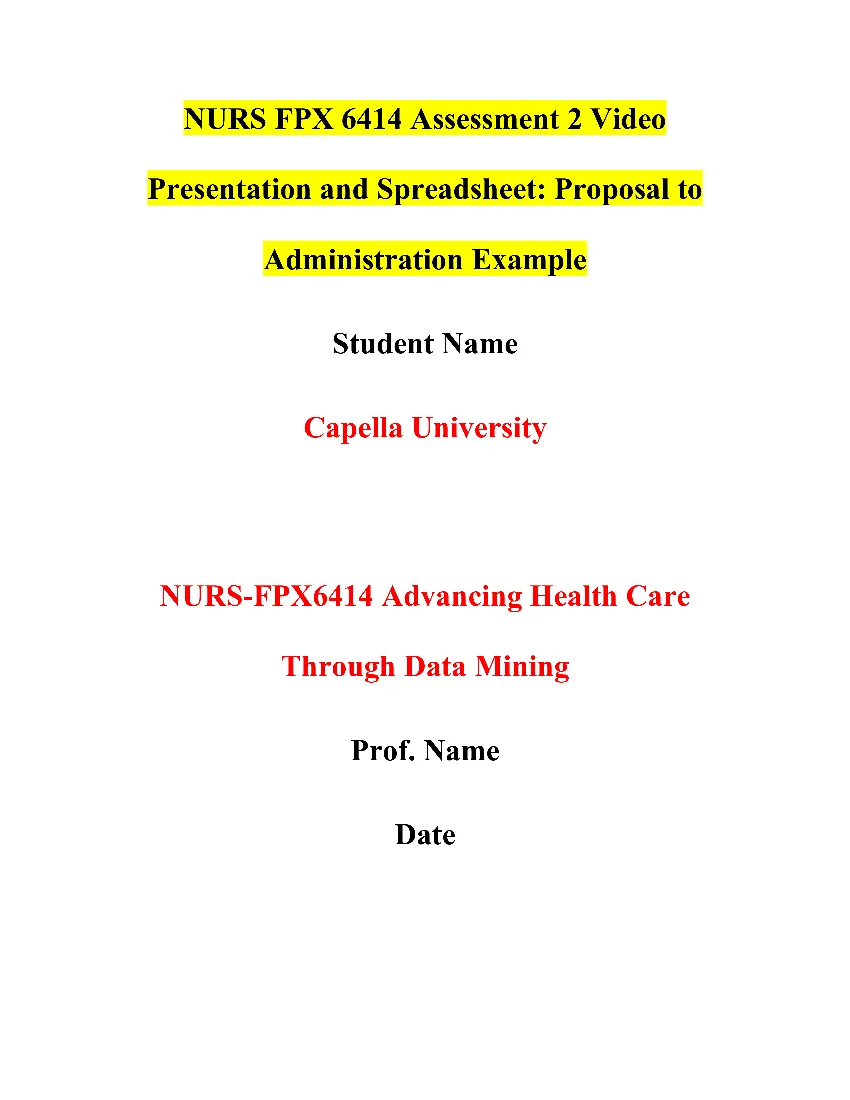 NURS FPX 6414 Assessment 2 Video Presentation and Spreadsheet: Proposal to Administration
NURS FPX 6414 Assessment 2 Video Presentation and Spreadsheet: Proposal to Administration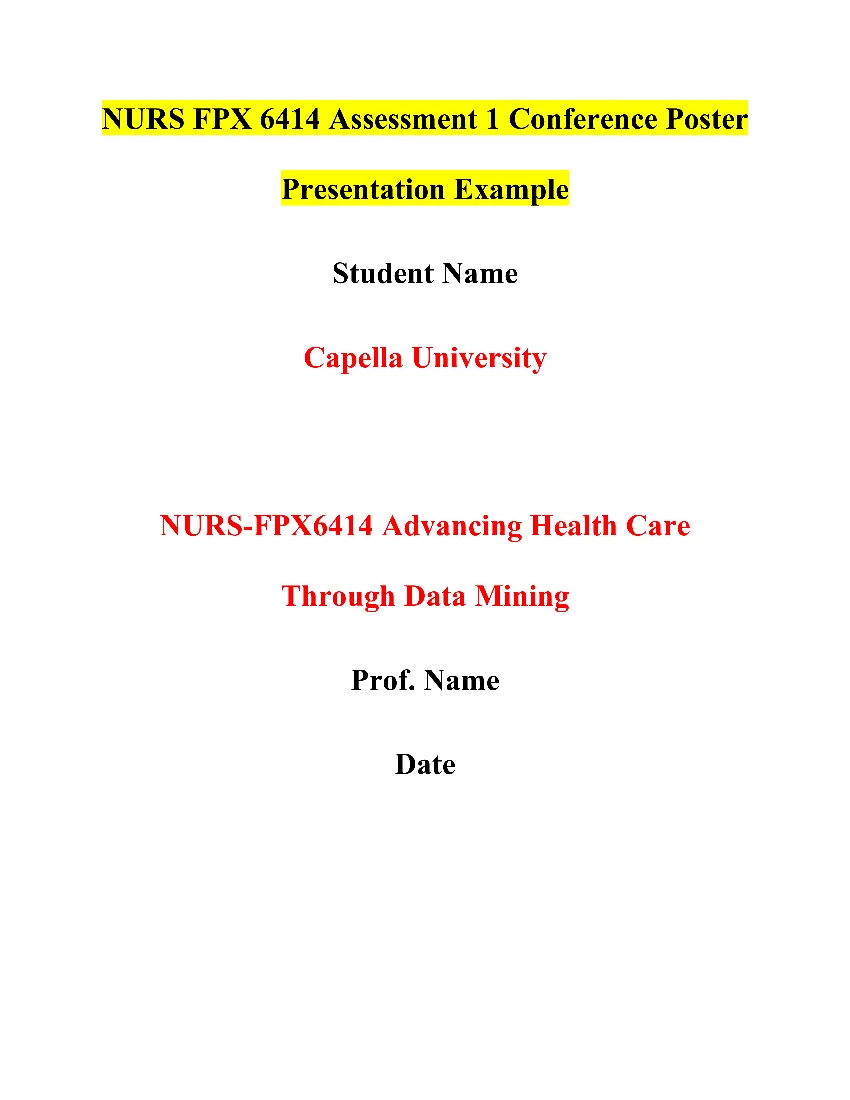 NURS FPX 6414 Assessment 1 Conference Poster Presentation
NURS FPX 6414 Assessment 1 Conference Poster Presentation